
10 minute read
Three is the magic number
magic number Three is the
Three stations, three platforms, three months
NIGEL WORDSWORTH
Proving that not all railway projects take an age to be completed, Network Rail recently designed, planned and delivered platform extensions at three stations in Sussex in a little over three months.
The works undertaken during three 52-hour possessions at Goring-by-Sea, Lancing and Cooksbridge provide a perfect example of the benefits of close collaboration, involving Network Rail, Govia Thameslink Railway (GTR), principal contractor Dyer & Butler and platform specialist MegaTech Projects.
The investment will enable the stations to comfortably accommodate longer, eight-car trains and resolve a long-standing issue of trains blocking the adjacent level crossings at all three stations. Network Rail contracted Dyer & Butler in January 2020 with the design only at GRIP 1 (Early Feasibility). With the first of the platforms needed by May, a timescale of just over three months, it was clear collaborative planning would be pivotal to the project’s success, and this began from the project launch.
The project saw Dyer & Butler (a part of M Group Services, and currently at number 17 on Network Rail’s list of top 20 infrastructure suppliers) joining forces with MegaTech Projects, its partner on previous platform extension programmes including; 11 platform extensions at seven stations in the North Cotswolds; eight platform extensions at four stations in the West Midlands and another platform extension in Cambridge.
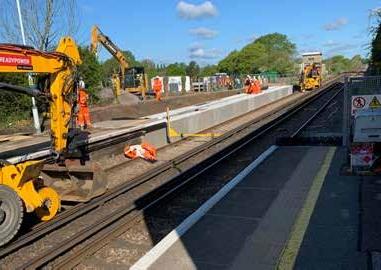
The project
The requirement for the platform extensions was driven by the introduction of longer, eight-car train formations and the need to support GTR’s new timetable, introduced during the £150 million upgrade of Gatwick Airport station.
Despite each station having two platforms, extensions were only required for one platform per station as the level crossings were only affected by trains travelling in one direction. Extending the platform would solve this long-standing issue by allowing trains travelling in that direction to stop alongside the platform and clear the level crossing. The MegaTech system
Described in detail in issue 178 (October 2019), the MegaTech system uses large blocks of expanded polystyrene (EPS) as its base. The blocks are pre-cut to size, with voids and channels for wiring and other
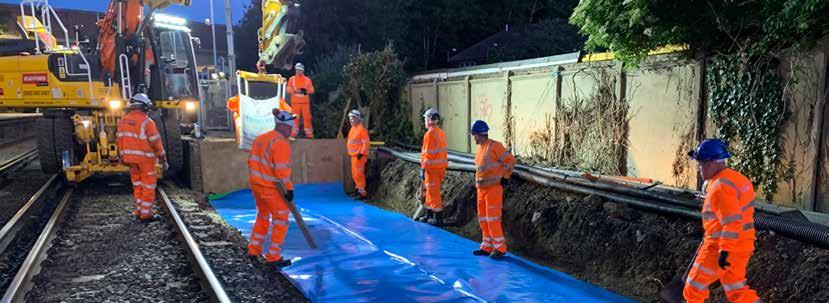

Multi-Disciplinary Consulting Engineers MEP, CIVILS, STRUCTURAL AND SUSTAINABILITYSERVICES
RAIL PROJECTS:
• AFA Schemes • Rewire / Relight • NSIP Schemes • Station Improvements • Junction Lighting • Rail Operation Centres (ROC) • Signalling Centres • HCE Surveys • Depots • Drivers Accommodation • Platform Extensions • Car Parks • Retail Property • New Station Buildings OUR SERVICES
• MEP & Sustainability Design • Civil / Structural Engineering • Architectural • BIM • Building Physics • Expert Witness • Surveys (Including Point Cloud) • CRE & CEM Roles • 3D Modelling
SPECIALIST SERVICES:
• OLE Design • Traction E&B • Signalling • Op Comms • SISS • SCADA • Environmental • P-Way

services included, and their exposed faces are clad in a layer of cementitious sheets for added protection.
The blocks are laid on a bed of sand and butted up, one against the other, with a plastic ‘T’ section protecting the joint. Once the blocks are in place, and the services installed in plastic ducting laid in the pre-prepared channels, large all-in-one concrete slabs are placed on top to form the platform surface.
The concrete slabs, manufactured by FP McCann, include both the coper and the tactile strip that warns passengers that they are close to the platform edge. The top face is acid-etched to provide a non-slip surface. Once the slabs are in place, lighting, fences and other platform furniture can be added.
The modular nature of the MegaTech system, with everything preformed at the factory, means that new platforms can be laid very quickly. As a rough guide, MegaTech works on delivering two metres of completed platform every hour, so a 40-metre platform would take 20 hours including blocks, services, surface slabs and fencing. Planning and design
Pre-works surveys of the three stations revealed that all three of the platforms to be extended were controlled by signals set some distance away, a real plus point as it would mean the extensions could be installed without having to move the signals.
Because of the complexity of the MegaTech system – outwardly very simple, but with every element slightly different to every other and requiring assembly in a specific order – the company uses experienced consultants to manage the design.
Dyer & Butler contracts manager Gareth Moss appointed MegaTech Projects to design the entire scheme.
The design team – Adams Design Associates for the civils, Crayside Consulting for the mechanical and electrical (M&E) elements and PBH Rail for the track adjustments – came through, and by early May, had moved the design from GRIP 1 to GRIP 6 (Construction, Test and Commission).
Throughout the process, Network Rail, GTR, Dyer & Butler and MegaTech held weekly progress meetings. It was a truly collaborative effort and, as a result, preparatory work began on time, taking place over three 52-hour possessions, with the process for each station very much the same.
Cooksbridge
The first station to be tackled was Cooksbridge, where the platform was extended by 45 metres. The ramp at the end of the platform was removed and replaced by a fence, a gate and a flight of steps. Existing services positioned in the way of the extension were


moved and the whole site was dug down to 200mm below sleeper level.
MegaTech then moved in to lay the sand foundation and start laying the polystyrene blocks, which were brought in by road in precise order.
The particular challenge at Cooksbridge was the presence of a high-voltage (HV) cable route running along the footprint of the extension and into an under-track crossing (UTX) chamber.
To accommodate this, MegaTech modified the design so that the first three EPS blocks were divided into six half-blocks, creating a void between them for the HV route to pass through the platform into the UTX. The slabs then spanned this void with an access chamber on the edge of the slab, with cast-in tactiles to allow for maintenance access to the UTX.
Once the EPS blocks were installed, M&E subcontractor Amaro was appointed to install the services in the pre-cut channels before MegaTech installed the concrete surface slabs.
Dyer & Butler’s fellow M Group Services business KH Engineering was appointed to manage the installation of customer information screens. Rail X finished off the civils, including a Rosehill Rail anti-trespass panel at the end of the platform.
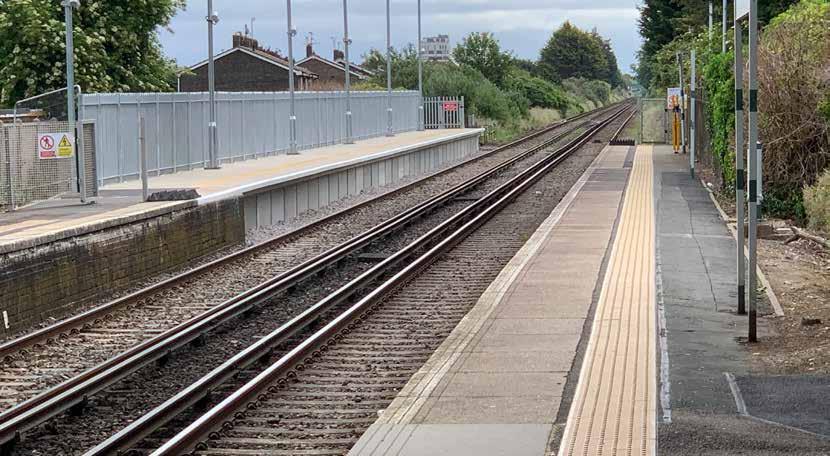
Goring-by-Sea
The platform extension at Goring-by-Sea was longer – 78 metres– but more straightforward, taking just 18 hours to install. The only added complication being the third contact rail that ran alongside the track in the footprint of the extension. Sonic Rail Services was brought in to move it from the cess into the six-foot. Lancing
The extension at Lancing was the longest of the three – 84 metres installed over 23 working hours during a 52-hour possession. Once again, there was an existing HV cable running through the footprint of the extension to address. Ensuring the cable remained undisturbed was essential for the agreed timescales to be met and so, once the route was surveyed, each EPS block was fabricated to sit around it.
Another challenge at Lancing was the presence of a pedestrian walkway to a large supermarket carpark to the rear of the platform. The walkway’s limited drainage meant that there was nowhere for rainwater to run off at the rear of the platform. Space restrictions also prevented MegaTech from using its standard guttering detail to the platform’s rear.
To overcome this issue, a ‘hit-and-miss’ design was used to create a one metre space (closed off with GRP trash screens) between each EPS block. This allowed rainwater to run off to the
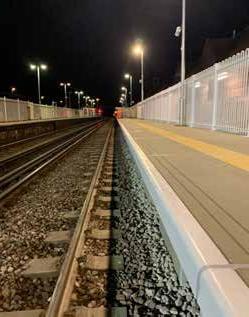

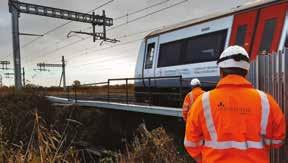
Our services include, but are not restricted to:
• Design and early stage involvement, including scoping and feasibility studies • Over and under bridge construction, repairs, strengthening and painting • Possession and access management • Construction, refurbishment and maintenance of station and line-side structures • Site investigations and hidden critical examinations • Installation of crash protection beams • Ground works, excavation, remediation and disposal • Embankment stabilisation • Level crossing renewals • Platform construction and renewals • Road, pavements and walkway construction • Ducting & Drainage • Building, mechanical and electrical works
rear of the platform and into the track drainage, a technique used previously for a platform extension at Moreton-in-Marsh station in Gloucestershire, a station prone to flooding.
The work at all three Sussex stations was carried out as scheduled and, following testing and signalling upgrades, the extended platforms were opened in early September.
Govia Thameslink Railway’s infrastructure director Keith Jipps commented: “The excellent collaboration between Network Rail and GTR, and the products and construction methods, enabled an impressively rapid completion of these platforms, despite the challenges the industry faced with COVID-19. We are really pleased to see the benefits this has brought to our train services for passengers and local community using the level crossings.”
“The big win was in programme efficiency,” explained Dyer & Butler contract's manager Gareth Moss. “The whole programme, delivered from early design to completion, was testament to the collaboration and determination of everyone involved. MegaTech’s modular system, and the collaborative approach taken by all parties, played an important part in delivering the programme within the timescale that was set.”
“Holding weekly meetings with all key stakeholders ensured everyone was kept up to speed and information was shared consistently. Having a 52-hour possession for each platform also meant we could get our heads down and get the work done.”
Patrick Gallagher, senior programme manager at Network Rail, added: “With the rail industry continuously being challenged to deliver schemes more quickly and efficiently, whilst also maintaining high levels of safety, these three schemes presented a fantastic opportunity to trial and test ways in which we could reduce design and delivery timescales. “When we launched the platform extension scheme on 22 January, we knew we had been presented with a significant challenge. In that first meeting, I called for collaboration, openness, honesty and, in the main, I believe we achieved all of that, otherwise we would not have been successful. “I am very pleased for everyone involved, as this shows what can be done when we work together which includes GTR our
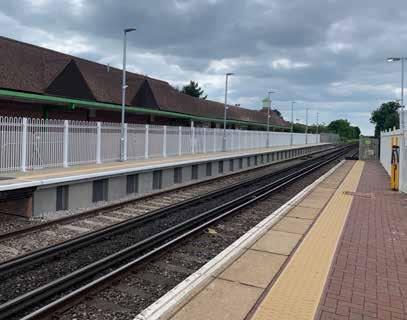
customer, who had their part to play. They are, of course, very pleased with the outcome. Dyer & Butler and MegaTech, I believe, worked very well together and that was key to the project’s success.”
Lancing MP, Tim Loughton, visited the platform extension at his local station and said: “This is a very helpful investment by Network Rail and GTR and will be welcomed by many of my constituents, who waste too much time waiting for barriers to go up, particularly during rush hour, simply because the platform cannot cope with eight-coach trains. Air quality will benefit too, as car engines idling less means fewer polluting emissions. It’s a win-win-win solution for drivers and pedestrians, passengers and the environment.”

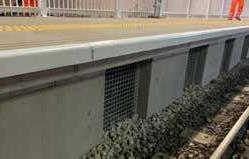
RAIL SAFETY WEEK 2021
21st – 27th June 2021 Building Safety Together











